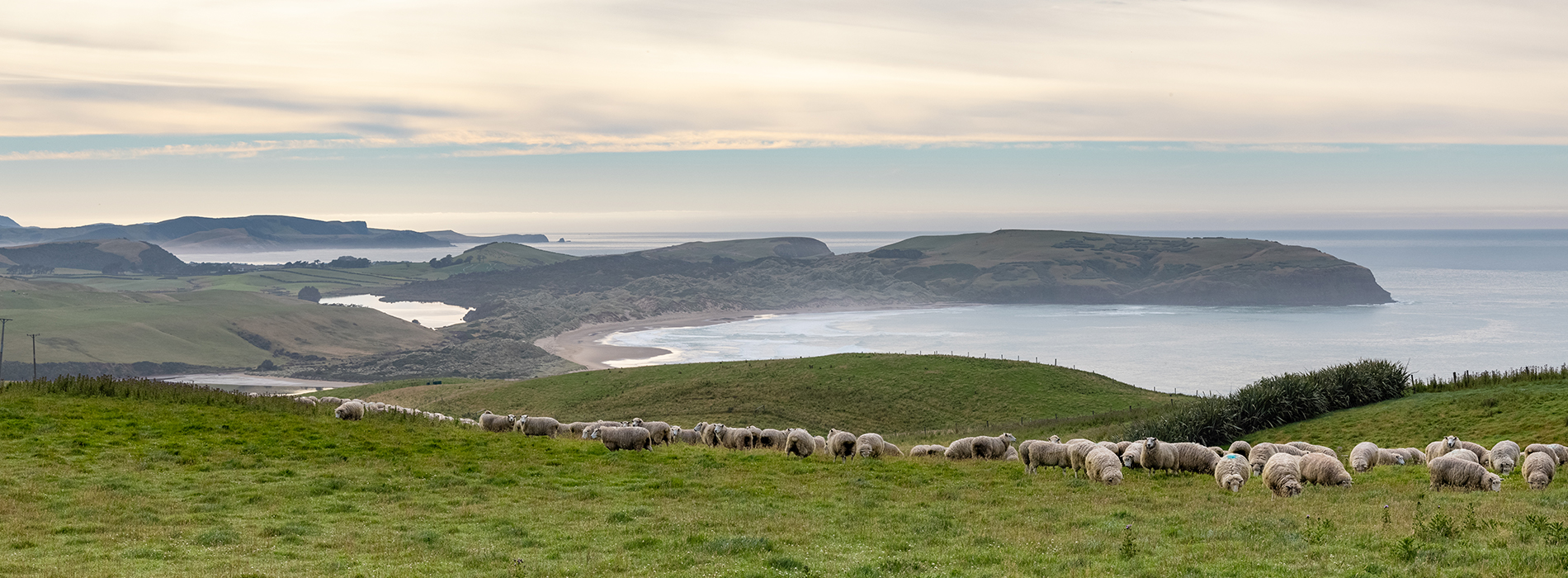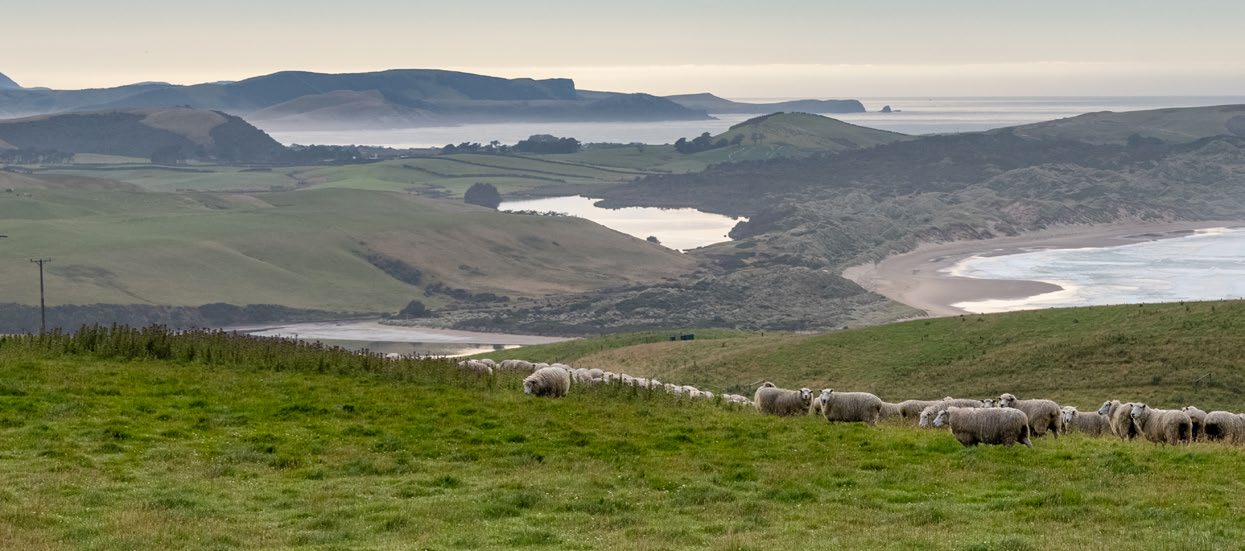
Culture Etc.

Above photo: Martin Haughey
About Town: Catlins
Closed borders prompt one “gullible North Islander” to head further south than she’s ever been before — and leaves her wondering why she didn’t make the trip earlier.
By Sharon Stephenson
In a small Catlins cafe, in the kind of one-horse town where even the horse is on holiday, a man with an elaborate neck tattoo is telling me about his dog. And how he once rode on the back of a whale. The further south you go, it seems, the bigger the tales get.
“Just don’t use my real name, eh,” he says, in the kind of voice that may or may not enjoy taking the mickey out of gullible North Islanders. I agree to refer to him as Snake Man, thanks to the tattoo of a snake that encircles his neck like a grapevine; he likes the nickname.
The rump end of New Zealand is a land of big yarns and dramatically indented coastlines, of skies the colour of deep bruises and wind that makes the trees grow sideways. If you fall off here, you’ll land with a cold bump in Antarctica. “Sometimes, this place can be hard to love,” Snake Man admits. “Don’t bother Googling ‘Catlins weather’. It’s sometimes cold all year round and bloody windy.” We’re from Wellington, I tell him, we know wind. Still, the gales that buffet our Curio Bay accommodation that night startle even us. But next morning, it’s as though the world has been wiped clean and we sit on our balcony overlooking Porpoise Bay, watching a handful of Hector’s dolphins play in the shallows. Snake Man had told us this might happen, that it’s the only place in New Zealand where the endangered species put in regular appearances.
Wedged between Invercargill and Balclutha, the Catlins has the South Island’s southernmost coastline, strung out between the Clutha and Mataura Rivers. It’s where you go to escape humanity and encounter the kind of characters drawn to this brooding landscape. People like Snake Man, and Edward Cattlin, who we learn about over a coffee that’s surprisingly good and immediately makes us feel guilty about our snobbish urban attitudes.
Cattlin was a British whaling captain, a man with two ts in his name (no one’s quite sure where the second one went) and a few spare quid which he used to “buy” around two million hectares of land in the 1840s. Rumour has it one of the five Maori chiefs he did the deal with Cattlin was a British whaling captain, a man with two ts in his name (no one’s quite sure where the second one went) and a few spare quid which he used to “buy” around two million hectares of land in the 1840s. Rumour has it one of the five Maori chiefs he did the deal with signed the document with a drawing of his face tattoo. Cattlin clearly had an eye for fetching real estate and fought hard to keep his land when New South Wales’ state borders were extended to include Aotearoa, exposing dodgy deals between whalers and local iwi (apparently, he never received title to the original claim). A quick tootle around Google shows that Cattlin ended up with only 92 hectares, and died not too long after.
Snake Man, who was born not far from where we’re talking, says forestry was the big ticket back in Cattlin’s day, with totara, matai and rimu milled to build houses across the lower south. It’s still a drawcard, but these days people come to see the fossilised remains of forests. As the flash interactive exhibits at the small but excellent Tumu Toka Curioscape Gateway Experience centre explain, 170 million or so years ago, when New Zealand was still part of Gondwana, vast tracts of matai and kauri forests were buried under the seafloor, where they became petrified. At Curio Bay, we wander along the walkway, marvelling at the tree trunks embedded in the shoreline which look a lot like rocks sticking out of the sand.
The rump end of New Zealand is a land of big yarns and dramatically indented coastlines, of skies the colour of deep bruises and wind that makes the trees grow sideways.

Walking home from dinner at the excellent Curioscape (no matter what the weather’s doing, order the southern seafood chowder, for which the ingredients will have been pulled from the water a few hours earlier), we come across groups of people at the petrified forest, looking out to sea.
They’re on hoiho watch so we join them, wishing we’d packed thicker jackets. Hoiho, or yellow-eyed penguins, nest around here. They’re the world’s rarest penguins and there are so many passive-aggressive signs around, warning visitors not to approach or touch the penguins, that I assume the beach must be teeming with them. Not so: after about an hour, we’re rewarded with the sight of a pair of tiny penguins as they waddle up the sand, the only two we see during our whole week in the Catlins.
I’m ashamed to say it’s my first time this far south. Before Covid crashed into the planet, a holiday wasn’t a holiday for me unless it involved a passport and a bottle of duty free gin. More fool me because this part of Aotearoa, where there are more cheese rolls than people and you can go for hours without seeing another soul, is simply stunning. On one outing, we walk across a farmer’s paddock, circumnavigating not-so-fresh cowpats, to get to Slope Point — the southernmost point of the South Island. This is the location for the obligatory photo at the AA sign. It feels like we’re the only ones left on the planet.
It’s the same at Nugget Point, site of the famous lighthouse, whose name comes from the sea-worn rocks that resemble gold nuggets. Apart from a bored DoC worker conducting a survey about the number of national parks people have visited, no one else is soaking up the vast skies and heaving seas. We do, however, provide lunch for hundreds of hungry mosquitoes who feast on our flesh, leaving angry welts that itch for days.
Despite the lack of people, I feel a deep connection to this wild and rugged land. I have no right to, having ignored this part of the country for so long. And I shouldn’t, because it’s cold and I’m pathologically afraid of the cold. But with each passing day, a little bit more of that rugged southern spirit soaks into my skin and I find myself scrolling through real-estate ads, wondering if I could live here. (In case you’re interested, house prices in the Southland region have increased to about $400,000. Contrast that with Auckland where you’ll get little change out of $1 million for a below-average house.)
For some mad reason, we start to miss people so we head north along the east coast to Owaka. The last time these things were reliably counted, Owaka had 303 residents; there aren’t many in evidence today but that could be because it’s Saturday and there’s rugby on the telly. We take photos at Teapotland, where one man’s obsession with teapots has gotten seriously out of hand, with pots in various states covering the front lawn, before getting out of the rain at Paper Road, a book store that also happens to sell motorbikes.
Fleeing Christchurch after the quakes, Tori Perrior and her partner Peter Knapton decided Owaka would be a good place to heal. Their store is a place where rare first editions and paperbacks share the same real estate as Knapton’s European road-racing and touring bikes. Perrior also makes beautiful soap and bath bombs that I take home for my grateful dog/house sitter.
It all sounds a bit daft and it is but, like so much of this great southern land, it somehow works.
Sharon Stephenson is a freelance writer who lives on the Kāpiti coast.
This story appeared in the August 2021 issue of North & South.

